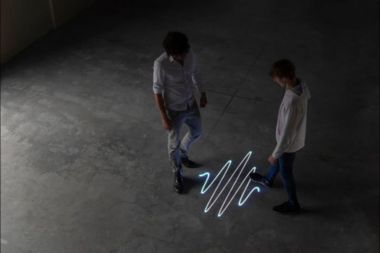Smart laser projection tech tracks visitor social distancing
A motion-tracking laser projection system has been developed to visually enforce social distancing in a creative way, creating laser shapes on the floor around people to enforce a 1.5 metre distance.

The smart system, titled the Smart Distancing System, combines motion tracking technology with computer-directed lasers that create a variety of shapes around people.
Designed as an art project by Nick Verstand and Jólan van der Wiel, the Smart Distancing System is designed for public spaces such as train stations, airports, museums, shopping centres and more, with circles of 1.5 metres able to be shown around multiple people. The system can also display a line between two people to demonstrate the distance between them. The system keeps identities anonymous by seeing people as 'points' in the system rather than gathering data on individuals.
Speaking exclusively to Inavate, Jólan van der Wiel said: “It started in March 2020 when I saw the tape lines coming into our world, it seemed like a temporary solution and not a clever way of using public spaces. If you put a tape line, it’s just one line for people to follow, it’s not dynamic.
The question was: how can you use technology to count people in a space in a fun and attractive way? The system sees where people are walking, in which direction they’re travelling and makes a decision on how far the distance should be. I worked with another artist, Nick Verstand, who specialises in auras around people, so we decided to use animations; We carried out custom software development and worked with Singa, a robotics company in the Netherlands that specialises in laser lights. We want to let the project grow from the Netherlands to Europe and beyond and we want to connect with local installation companies.”
Van der Wiel added: “There is a motion-tracking camera that ‘sees’ you without gathering your data with laser projection which allows us to see how people are walking, what the distance is between people, forming a straight line between people that will begin to move if they move too close to another person.
"This technology works for chaotic areas where people want to move from A to B, it’s a good way to use it in specific places such as school entrances, stations and airport terminals as well as events and fairs.”
Van der Wiel also foresees future applications beyond the immediate need for social distancing in a post-Covid-19 world. Van der Wiel explained: “It’s the start of ‘smart guiding’ for airports, healthcare and more.
"Digital technology will continue to merge with real life and we see growing potential in cases such as healthcare where we are getting a lot of requests, for example, where people don’t know how to get back to their rooms when they suffer from Dementia. We don’t know exactly where this technology will be used, but we want to use the system as a smart guiding system in the future.”
Taken from Inavate. 2 February 2021.
Visit the Inavate website for more information.
Posted: 2nd March 2021